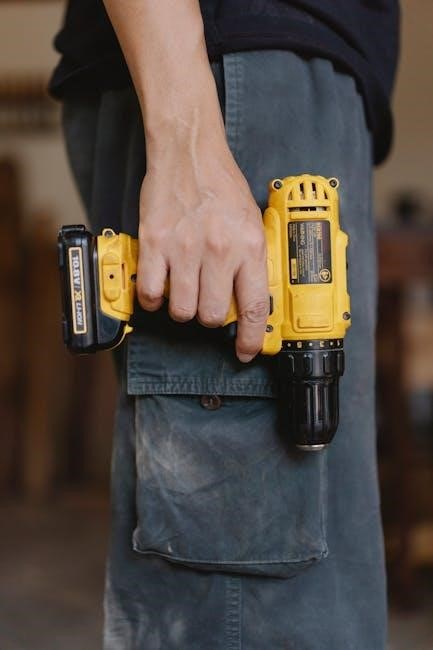Welcome to the Stalker DSR 2X manual. This guide introduces the Stalker DSR 2X, a advanced police radar system designed for law enforcement professionals. It provides detailed information on features, operation, and maintenance to ensure optimal performance and safety.
1.1 Overview of the Device
The Stalker DSR 2X is a cutting-edge police radar system designed for law enforcement professionals. It combines advanced radar technology with user-friendly operation to deliver accurate speed measurements and target tracking. The device is built for versatility, supporting both stationary and moving modes of operation. With its dual-antenna design, the DSR 2X provides directional sensing capabilities, enhancing officer safety and situational awareness. Its compact design allows for easy installation in patrol cars or motorcycles, making it a versatile tool for traffic enforcement. The system is engineered to provide reliable performance in various environmental conditions, ensuring accuracy and consistency in speed monitoring.
Featuring true Doppler audio and target locking, the DSR 2X offers real-time feedback, enabling officers to focus on their surroundings while maintaining precise radar monitoring. Its advanced DSP technology ensures superior signal processing, reducing interference and improving target detection. The device is complemented by a range of operational modes and alerts, including rear traffic alerts and patrol car speed monitoring, making it a comprehensive solution for modern law enforcement needs.
1.2 Key Features and Benefits
The Stalker DSR 2X boasts an array of innovative features designed to enhance law enforcement operations. Its dual-antenna technology provides precise directional sensing, while true Doppler audio offers real-time target feedback. The system includes advanced target locking and patrol car speed monitoring, ensuring accurate speed measurements. Rear traffic alerts improve officer safety by detecting approaching vehicles. With its DSP technology, the DSR 2X delivers superior signal processing and reduced interference. These features combine to provide a reliable, user-friendly radar solution for traffic enforcement, ensuring accuracy and efficiency in various operational scenarios.
Officers benefit from its intuitive design, reducing distractions while maintaining high situational awareness. The device’s versatility supports both stationary and moving operations, making it ideal for diverse law enforcement needs. Its ability to integrate seamlessly with patrol vehicles enhances overall performance and safety.

Installation and Setup
Proper installation ensures optimal performance. Mount the unit securely, connect antennas, and power supply. Follow calibration steps for accurate readings and reliable operation in all conditions.
2.1 Physical Installation Requirements
The Stalker DSR 2X requires careful physical installation to ensure optimal performance. Mount the unit securely in a stable location, such as a patrol car dashboard or motorcycle. Dual antennas must be installed with a clear line of sight to avoid signal obstruction. Ensure the power supply is stable and meets the system’s voltage requirements. Proper grounding is essential to minimize interference. Follow the manufacturer’s guidelines for antenna alignment and spacing to maximize accuracy. Always verify the installation environment is free from obstructions that could interfere with radar signals. Adhere to all safety precautions during the installation process to avoid damage to the unit or vehicle.
2.2 System Configuration and Calibration
After installation, configure the Stalker DSR 2X by setting up the operating parameters using the provided software tools. Calibrate the system to ensure accurate readings, particularly for speed measurement and target locking. The True Doppler Audio feature must be fine-tuned to deliver clear and reliable sound feedback. Use the VSS (Vehicle Speed Sensor) input to synchronize the radar with the patrol car’s speed, enhancing accuracy in moving mode. Regularly update the system software to maintain optimal performance and access new features. Always refer to the quick-start guide for step-by-step calibration instructions to avoid errors and ensure proper functionality.

Operating Modes
The Stalker DSR 2X operates in stationary and moving modes, providing adaptability for various law enforcement scenarios. Its advanced technology ensures precise speed measurement and target tracking in both settings.

3.1 Stationary Mode Operation
In stationary mode, the Stalker DSR 2X measures the speed of moving targets using the Doppler shift principle. The radar emits a signal that reflects off vehicles, calculating the frequency shift to determine speed. This mode is ideal for fixed traffic monitoring, offering high accuracy and reliability. The system automatically locks onto targets and provides audible and visual alerts. Officers can set specific speed thresholds for alerts, enhancing enforcement efficiency. The radar’s advanced DSP technology ensures minimal interference and precise measurements, making it a trusted tool for traffic enforcement in stationary deployments.
3.2 Moving Mode Functionality
The Stalker DSR 2X’s moving mode enables officers to monitor speeds while the patrol vehicle is in motion. Using the patrol car’s speed sensor (VSS), the radar calculates relative speeds accurately. Dual antennas track targets in both front and rear, ensuring comprehensive coverage. The system automatically adjusts for the moving platform, providing precise speed measurements. True Doppler audio enhances target identification, while the radar’s DSP technology minimizes interference. This mode is ideal for dynamic traffic enforcement, allowing officers to monitor multiple targets effectively while maintaining mobility. It ensures accurate speed enforcement even in challenging, moving environments.

Advanced Features
The Stalker DSR 2X offers dual antenna technology, true Doppler audio, and rear traffic alerts for enhanced accuracy and officer safety. Its advanced DSP technology ensures reliable performance in dynamic environments, providing versatile functionality for law enforcement operations.
4.1 Dual Antenna Technology
The Stalker DSR 2X incorporates dual antenna technology, enhancing its ability to detect and track targets with precision. This advanced system enables direction sensing, allowing officers to identify whether targets are approaching or receding. The dual antennas work in tandem to provide accurate speed measurements and reduce interference from external sources. This feature is particularly beneficial in both stationary and moving modes, ensuring reliable performance in various operational scenarios. By leveraging dual antennas, the DSR 2X achieves superior target separation and improved accuracy, making it a robust tool for law enforcement professionals. This technology also supports rear traffic alerts for enhanced officer safety.
4.2 True Doppler Audio and Target Locking
The Stalker DSR 2X features True Doppler Audio, providing officers with real-time auditory feedback on target movements. This technology ensures accurate speed detection by analyzing frequency shifts; The system also includes a robust Target Locking function, enabling it to focus on specific targets, such as the fastest-moving vehicle, even in multi-target environments. The audio tones adjust based on the target’s approach or departure, enhancing situational awareness. This combination of audio feedback and precise locking ensures reliable operation, reducing operator error and improving traffic monitoring efficiency. The True Doppler Audio and Target Locking capabilities make the DSR 2X an indispensable tool for law enforcement professionals.
4.3 Patrol Car Speed Monitoring
The Stalker DSR 2X includes Patrol Car Speed Monitoring, which integrates with the vehicle’s speed sensor (VSS) to provide accurate ground speed measurements. This feature ensures precise radar operations, even when the patrol car is moving. The system automatically adjusts target speed calculations based on the patrol car’s velocity, enhancing accuracy in traffic monitoring. Officers can rely on this functionality to maintain consistent and reliable speed enforcement, reducing potential errors during traffic stops. The Patrol Car Speed Monitoring capability is a critical component of the DSR 2X, ensuring seamless performance in dynamic environments while supporting officer safety and efficiency.
4.4 Rear Traffic Alert Functionality
The Stalker DSR 2X features a Rear Traffic Alert system, designed to enhance officer safety by detecting vehicles approaching from behind. This functionality provides real-time alerts, enabling officers to respond to potential threats while conducting traffic stops or monitoring roadways. The Rear Traffic Alert works seamlessly with the radar’s dual antenna technology, ensuring accurate detection and minimizing false alarms. By improving situational awareness, this feature contributes to safer operations and reduces the risk of collisions or unexpected incidents. It is an essential component of the DSR 2X, supporting both traffic enforcement and officer protection in dynamic environments.

Officer Safety and Alerts
The Stalker DSR 2X includes an Officer Safety Alert System, enhancing safety during traffic stops by providing real-time alerts for approaching vehicles, minimizing distractions and ensuring officer focus.
5.1 Officer Safety Alert System
The Stalker DSR 2X features an advanced Officer Safety Alert System designed to enhance situational awareness during traffic stops. This system provides real-time alerts for approaching vehicles, minimizing distractions and ensuring officer focus. It detects movement around the patrol car, offering an additional layer of protection. The alerts are timely and precise, allowing officers to respond appropriately. This feature is particularly useful in high-risk scenarios, ensuring officer safety remains a top priority. By integrating seamlessly with the radar’s functionality, the system operates without interfering with other operational modes, making it a critical tool for modern law enforcement.

Technical Specifications
The Stalker DSR 2X utilizes a state-of-the-art Digital Signal Processor (DSP) for precise target detection and accurate speed measurements. Its advanced engineering ensures reliability and durability in various environments.
6.1 Digital Signal Processor (DSP) Technology
The Stalker DSR 2X leverages cutting-edge Digital Signal Processor (DSP) technology to deliver unparalleled accuracy and performance. The DSP enhances radar signal processing, enabling precise speed measurements and target detection. It ensures minimal interference and optimal clarity in various operating conditions. With advanced algorithms, the DSP improves the system’s ability to distinguish between multiple targets and maintain consistent accuracy. This technology is crucial for both stationary and moving operations, providing law enforcement with reliable data for traffic monitoring and enforcement. The DSP’s robust processing capabilities make the DSR 2X a trusted tool for modern policing needs.
6.2 Frequency and Range Capabilities
The Stalker DSR 2X operates on a specific frequency band optimized for law enforcement applications, ensuring accurate speed detection across its range. The radar system is engineered to detect speeds with high precision, even at extended distances, making it effective for both stationary and moving operations. Its range capabilities allow officers to monitor traffic flow and detect violations reliably. The system’s frequency and range features are designed to minimize interference and maximize performance in various environmental conditions, providing law enforcement with a dependable tool for traffic monitoring and enforcement. This ensures accurate and consistent results in real-world scenarios.

Operator’s Manual
The Operator’s Manual provides essential information for the safe and effective use of the Stalker DSR 2X, including guides for operation, legal notices, and reference materials.
7.1 Contents and Structure
The Operator’s Manual for the Stalker DSR 2X is organized into clear sections for easy navigation. It begins with an introduction to the device, followed by installation and setup instructions. Detailed descriptions of operating modes, advanced features, and technical specifications are included to ensure comprehensive understanding. Maintenance requirements and troubleshooting guides are also provided to support long-term use. Legal and confidentiality notices are emphasized to protect proprietary information. The manual is designed to be user-friendly, ensuring officers can efficiently utilize the radar system while adhering to all operational and legal standards.
7.2 Legal and Confidentiality Information
This manual contains trade secret and protected information exempt from public disclosure under various state laws. Unauthorized distribution or reproduction is strictly prohibited. The contents are confidential and intended solely for authorized personnel. Users must comply with all applicable laws and regulations when operating the Stalker DSR 2X. The manufacturer reserves all rights to the information provided and disclaims liability for any misuse of the system. By using this manual, officers acknowledge their understanding of and commitment to maintaining confidentiality and adhering to legal standards.

Downloads and Resources
Access the Stalker DSR 2X product brochures, quick-start guides, and troubleshooting manuals for comprehensive support. Visit the official website for downloads and additional resources.
8.1 Product Brochures and Guides
The Stalker DSR 2X product brochures provide an overview of the radar’s features, including dual antenna technology and true Doppler audio. These guides detail the system’s capabilities, such as stationary and moving mode operations, as well as advanced functions like target locking and rear traffic alerts. Available for download, the brochures offer insights into the radar’s technical specifications, including DSP technology and frequency range. They also highlight the officer safety alert system and patrol car speed monitoring. These resources are essential for understanding the DSR 2X’s versatility and ensuring its effective use in law enforcement applications.
8.2 Quick-Start and Troubleshooting Manuals
The quick-start manual provides a concise guide to rapidly deploy the Stalker DSR 2X, ensuring officers can begin operations efficiently. It outlines essential steps for system activation, basic mode selection, and initial configuration. The troubleshooting manual addresses common issues, such as antenna alignment, signal interference, and software glitches, offering step-by-step solutions. Both resources are designed to minimize downtime and optimize system performance. Additional troubleshooting tips and FAQs are included to resolve operational challenges swiftly. These manuals are indispensable for maintaining peak functionality and addressing unexpected issues in the field.

Maintenance and Support
Regular maintenance involves cleaning antennas and checking for software updates. Proper antenna alignment is crucial for accurate readings. Contact customer support for assistance with any issues;
9.1 Regular Maintenance Requirements
Regular maintenance is essential to ensure optimal performance of the Stalker DSR 2X. This includes cleaning the antennas to prevent debris buildup and verifying proper antenna alignment. Periodically check for software updates to maintain the latest features and security patches. Inspect the radar unit for physical damage and ensure all connections are secure. Failure to maintain the device may result in reduced accuracy or system malfunctions. Refer to the operator’s manual for detailed maintenance procedures and schedules to keep the DSR 2X functioning at its best.
9.2 Customer Support and Assistance
The Stalker DSR 2X is backed by dedicated customer support to address technical inquiries, troubleshooting, and maintenance needs. Users can contact support via phone or email for assistance. Additionally, online resources, including product manuals and troubleshooting guides, are available for download. The manufacturer also offers training programs to ensure operators maximize the device’s capabilities. For critical issues, prioritize reaching out to authorized support channels to maintain compliance with legal and operational standards. Regular updates and support ensure the DSR 2X remains reliable and effective for law enforcement operations.
The Stalker DSR 2X is a cutting-edge police radar system designed for accuracy and reliability. This manual has guided you through its features, installation, operation, and maintenance. With advanced technologies like dual antennas and true Doppler audio, it ensures precise speed measurements and enhanced officer safety. Regular updates, customer support, and comprehensive resources guarantee optimal performance. By following the guidelines outlined, officers can effectively utilize the DSR 2X to enforce traffic laws and maintain public safety. This device remains a vital tool for modern law enforcement, combining innovation with user-friendly design to meet the demands of the field.










